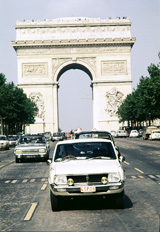
Advancing with the times
The Familia, which debuted as a genuine family car in 1963, underwent its first full redesign in 1967, when it was given a modern oval body shape. The rotary-engined Familia R100 was introduced in 1968, following the launch of the Cosmo Sport. With its distinctive round rear lights, the Familia Rotary featured a 491cc x 2 10A rotary engine that developed 100ps and had a top speed of 180 kilometers per hour. It also accelerated from standstill to 400 meters in as little as 16.4 seconds. This performance put it at the top of its class. Emitting a unique high-pitched exhaust note, the Familia Rotary Coupe recorded its maiden victory at the Grand Prix of Singapore in 1969, and performed impressively at circuits in Belgium, Germany, the UK and South Africa.
The first oil price shock struck in 1973. The period also saw a growing demand for exhaust emissions regulations and improved safety. Mazda's third-generation Familia made its debut in this severe climate. The new Familia offered improved comfort and control and in 1976 adopted lean-burn technology and Mazda's original oxidizing catalyst. This version earned a strong reputation for its practical value.
The Familia Hatchback appears in the movie, 'The Yellow Handkerchief of Happiness'
The fourth-generation Familia was launched in 1977 after the oil price shock had ended and the business climate was beginning to recover. At the time, two-box hatchbacks were predominant in Europe's compact car market. The Familia targeted the youth market, and its styling was based on four themes: new values, versatility, economy and high quality, and these themes were sustained in subsequent iterations.
A bright red five-door hatchback Familia appeared in the movie, 'The Yellow Handkerchief of Happiness' driven by the character Kinya Hanada who was played by Tetsuya Takeda. The interest sparked by the movie was maintained with the subsequent, very popular 'Red XG' Familia.
To be continued in Part 3 of the Familia Series

Second-generation Familia


